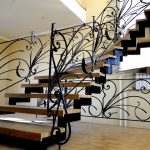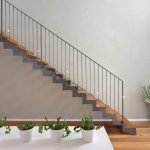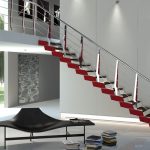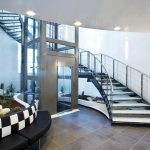A staircase is an indispensable element of a multi-storey building. The design for safety is complemented by handrails, which play a functional and decorative role, since without the railing the staircase will look unfinished. To ensure reliability, one should not only take into account the optimal parameters, but also use high-quality materials. Railings for stairs made of metal are reliable, they have an attractive appearance that complements any design.
Content [Hide]
- 1 What are metal railings: what elements are they made of?
- 2 Types of railings for stairs in a private house: characteristics
- 3 The main materials used for the manufacture of handrails: photos of exquisite options
- 4 How to decide on the design of the railing: drawings of stairs
- 5 Railing for a staircase made of metal: the main requirements for products
- 6 What elements should be present in the railing for spiral or marching stairs
- 7 How to weld a railing with your own hands: the necessary tools, the main stages of work
- 8 How to equip a staircase with handrails yourself: important installation tips
- 9 Some ideas for creating beautiful metal railings
What are metal railings: what elements are they made of?
The stairs connecting the floors of the house can be simple, unremarkable, or they can be works of art. Despite the fact that the main function of the railing is to ensure safety, the choice of design should be approached correctly, and you also need to correctly determine the type and size of steps.

The main function of the handrail is to ensure safety, but the design should not be forgotten either.
Fact! If you look at various photos of stair railings in a private house, it immediately becomes clear that metal structures are most often used for decoration.
Before making a railing for a staircase, you need to decide what the fence is for and what structural details are at the heart. So, if we turn to the definition of the word, a railing is called a fence, which includes the following elements:
- Racks and balusters. They are not only decorative, but also load-bearing and protective elements.
- Handrails. Important structural items that play the role of support for a person during ascent and descent.
- Internal filling. It is a protective element of the staircase.
As for the internal filling of metal stair rails, they are also divided into types:
- Classic. Consists of handrails and balusters.
- Solid. It is made from a solid sheet of metal or other material.
- Rigeli. They look like crossbars, which are located parallel to the main handrails.
Features of metal railing for porch and stairs
The railings in the house not only provide security, but also help create a harmonious and complete interior design. That is why the appearance of structures is of great importance. The main reason why it is recommended to install railings on the balcony and other potentially dangerous structures is the prevention of injuries and accidents. It is the barriers that protect the residents of the house from falls from a height. Among the main advantages of installing metal railings for stairs in the house or outdoors, the following stand out:
- Unlike other structures, metal structures are distinguished by their durability and strength. Even after a while, the fences will not begin to creak or deform.
- Metal is considered a versatile material that can be easily combined with wood, glass or stone elements.
- Metal parts are malleable, so it is easy to make elements of various shapes from them. It can be both regular geometric shapes and a variety of fantasy elements.
Other advantages of using metal for stair railings:
- incombustibility and fire resistance;
- resistance to temperature and humidity extremes, which allows you to install railings for stairs outdoors;
- long service life without repairs or updates;
- ease of care;
- the ability to use in any interior style - from classics to laconic loft and high-tech;
- increased resistance to mechanical stress;
- high strength;
- ease of processing using various tools;
- the ability to make simple options yourself.
To improve the appearance of the finished railing, several finishing methods are used for the main elements:
- Anodizing. The result is a chrome-plated stair rail.
- Coloring. With the help of special paint, fences can be given any color that matches the environment.
- Polishing. Gives shine and smoothness to surfaces.
- Satin finish. It is carried out by using sandblasting equipment. In the photo of the railing, you can see how such structures look.

To improve the appearance of the railing, anodizing, painting, polishing or satin finishing is applied
Among the disadvantages are the susceptibility of metal elements to corrosion and oxidation. But modern processing technologies, involving the use of special solutions, make it easy to cope with the problem. The main thing is to choose the right mixture and adhere to the rules of application.
Types of railings for stairs in a private house: characteristics
Depending on the manufacturing method, fences are divided into several types:
- prefabricated;
- welded;
- forged;
- cast;
- combined.
Prefabricated products are made of steel or aluminum parts. It is important to take into account that after installation, all steel elements must be painted, and a special anti-corrosion coating must be applied to aluminum parts. Such structures are usually inexpensive, lightweight and easy to install.
Welded railings are more complex. Their main advantage is the absence of joints between the elements. Among the minuses, there is a high susceptibility to corrosion of structures.

Depending on the manufacturing method, metal railings are divided into prefabricated, welded, forged, cast and combined
Expert advice! For the manufacture of welded railings, it is best to use argon welding, which gives a neat seam and does not form splash marks.
Forged products in most cases are made by hand, which requires significant physical and time costs. But the result of the work is a beautiful railings with an original appearance. Most often they are custom-made. The items are expensive, but they look luxurious, especially if various methods were used during processing, by means of which the metal is specially "aged" or given a gilded look. Often, forged railings are decorated with openwork or massive elements.
For the production of cast railings, special forms are used, where molten metal is poured, more often it is bronze, cast iron or brass. Custom made products will be expensive, while the price of finished products in stores is slightly lower. Each option has a unique appearance that fits perfectly into any interior.
When performing combined railings, a combination of materials is used, often exactly those that are used to create the interior or exterior of the house. Thus, it turns out to install a railing that fits perfectly into the environment.
Whichever type of stair railings is chosen, it is important to take into account that their height should not be less than 90 cm. Railings can only be installed on one side. If the width of the structure is more than 1.25 m and there is no wall on the other side, then the railings are recommended to be mounted on both sides.
The main materials used for the manufacture of handrails: photos of exquisite options
There are various types of metal stairs that are installed outside or inside buildings. By the method of installation, structures are divided into stationary and mobile. Mobile options are mainly needed only for performing repair or household work, this also includes ladders. Popular designs are folding or sliding systems, which are used to lift to the attic or attic. Let's take a closer look at other types of stairs.
Marching. They belong to the most convenient from the point of view of safety of movement of people. Structures consist of straight spans. If a turn is required, platforms or winders are installed. It is not recommended to do more than 15-16 steps in one march.
Screw. Another name is spiral staircases, which look not only beautiful, but also aesthetically pleasing. The turn is formed due to smoothly curved structures. Spiral staircases are considered safe and comfortable. They will not only decorate the room, but also become an element that allows you to competently organize the movement.

When choosing material for railings, not only the preferences of the owners, but also the budget play a significant role
Various materials and technologies are used to make stairs and stair railings. A significant role in the choice is played not only by the personal wishes of the household, but also by the budget allocated for the manufacture of railings. In most cases, metal is used to create the main elements, as well as wood, which is also great for creating fences that match any interior design.
The main advantage of wooden railings is the ability to decorate them with carved or patterned details. In addition, various shades of wood can be used to make them. But wood products will never be able to match the strength of metal products, which are guaranteed to last longer. Metal handrails for the stairs can be made from scrap materials:
- pipes;
- fittings;
- metal profile;
- welded elements.
If you look at the photos of ready-made options, you can pay attention to the fact that the railings look the most attractive, complemented by decor, which is plastic, glass, textiles, ropes and other suitable materials.
Features of the handrail for the stairs to the house, made of ferrous metals and cast iron
The most economical option for a porch, balcony or staircase rail is a ferrous metal fence. As you know, the materials have some drawbacks, but to improve the performance, a powder coating or enamel is applied to the surface of the products. This allows you not only to endow the handrails with strength, but also to choose the desired color.
Fences can be used to equip multi-storey buildings, offices and residential buildings. Cast iron structures are in harmony with the steps made of various materials, look especially good in combination with facing wood and marble tiles. At the same time, ready-made options may have a simple appearance or differ in an unusual design.
Cast iron railings are ideal for balconies that face the street, because the products are resistant to temperature extremes and direct sunlight. It is the increased performance and attractive appearance that make cast-iron fences the best option for the home.
Helpful information! Railings made of ferrous metal are susceptible to corrosion, therefore, it is recommended to apply protective compounds to the products from time to time.
If the method of artistic casting is used for manufacturing, unusual weaves and patterns can be made from cast iron. The finished structure looks easy, but at the same time emphasizes the richness of the structure. Almost all products are made according to a unique design, where each element is an integral part of the composition.
Related article:
Stainless steel railings: types, features, installation and maintenance
Railing requirements. Advantages and features of use. What are the railings. Self-assembly and maintenance.
Using the method of casting and forging, craftsmen get real works of art from cast iron. Such products, in addition to attractiveness, are reliable structures designed for heavy loads and retaining an attractive appearance for several decades.
Other metals used to make metal stair railings
For the price, stainless steel stair handrails are more expensive than ferrous metal, but they are great for both outdoor and indoor use. The increased resistance to weathering is the reason why stainless steel railings are most often used for porches. Metal railings retain their appearance for a long time, and also differ in decorative qualities, so this option can often be seen outside and inside the house.
Most often, it is polished stainless steel that is used for the manufacture of fences, which has a large number of advantages:
- wear resistance;
- strength;
- simple care;
- no need to update the color;
- the possibility of combining with other materials.
In order to create unusual ornaments or geometric shapes from stainless steel, the metal is cold-processed. An important advantage is the absence of corrosion even without painting. Average service life is 50 years.
Steel, unlike stainless steel, is subject to corrosion, so a thin layer of powder coating is required on all elements.This will allow the various elements of the metal handrails for the stairs to give almost any shade, making it interesting and fun to beat the stairs in the interior. The cost of steel fences is 20-30% less than the price of the stainless option.
But steel products have significant drawbacks. So, fences, consisting of complex figured elements, are assembled from several parts, which are attached to each other by welding directly during the installation of the staircase itself. To avoid the appearance and spread of corrosion, the joints remaining as a result of welding are ground and painted.
Aluminum, like stainless steel, perfectly resists the negative influence of external atmospheric factors. Plasticity and low weight are considered important advantages of aluminum. Due to this, on trading floors you can find fences that differ in different geometries and colors.
A large number of advantages have led to the fact that aluminum railing for stairs in a private house is very common. But due to the fact that aluminum is less durable than steel or stainless steel, such fences are not recommended to be installed in public or office premises.
Brass is a metal that is obtained by mixing zinc and copper, in some cases nickel or tin acts as an additional element. The material has a golden hue that will add luxury and richness to the interior. This option is often found in classic interiors: modern, baroque, rococo and others.
A railing made of brass will look even more attractive if you use a combination of glass, wood and stone with metal. After applying a special composition, the brass surfaces of the railing acquire a shine, their strength improves. It is most important to combine brass with elements of artistic forging.
How to decide on the design of the railing: drawings of stairs
To create a harmonious interior, you should choose not only the right type, but also the design of the fences. You need to understand that a staircase without a railing will not look complete, therefore, even if the structure is small, it will look better together with the supports. To find the perfect design, you should turn to the ready-made options on the Internet. If imagination permits, you can create a sketch yourself, using simple computer programs.
You can improve the appearance of the metal surface using the artificial aging method. In addition, depending on the surface, it is given gold, silver or any other shade. For example, to improve the appearance of stainless steel, it is not required to cover the metal with paint and varnish solutions: as in the case of aluminum, a polymer, nickel-plated or chrome coating is used.
To emphasize the style of the railings, you should choose the right railings correctly. For safe and comfortable use, their surfaces must be smooth, free from joints, seams or other uneven or pointed elements.
Helpful advice! If you want the staircase to look complete and attractive, you need the handrails to extend 30 cm beyond the line of the bottom step. To reduce the likelihood of injury, it is better to make the edge rounded.
Railing for a staircase made of metal: the main requirements for products
After you have chosen a specific model of the fence, you can try to install the railing for the stairs with your own hands. But first you need to familiarize yourself with certain nuances:
- a welding machine will help to fix a metal railing on a metal staircase;
- if the staircase is made of concrete, for reliability, metal mortgages must be installed in the base;
- bolted connecting mechanisms are used to fasten the supports to a wooden staircase.
Before making a railing on the stairs, you need to think about the comfort of using the structure. To do this, you need to take into account the following points:
- the height of the balusters should not exceed 1 m;
- there should be no visible defects on the jumpers;
- it is necessary that the handrails fit comfortably in the hand;
- the minimum load for which the fences are designed should not be less than 100 kg per square meter of the fence;
- it is recommended to leave 70 cm between the racks.
So that a person does not injure his hands while lifting, it is necessary to maintain a sufficient distance between the wall and the handrail. It is important not to forget that the main function of the railing is to ensure safety when moving between floors, climbing a high porch or while being on the balcony. That is why it is necessary to strictly adhere to the key parameters. So, according to SNiP and GOST standards, when installing railings on the stairs, you must adhere to the following parameters:
- in accordance with the standards of GOST 25772-83, the optimal height of the fence is 90 cm;
- handrail section - 5 cm;
- the distance between the balusters is 10-15 cm;
- the gap from the nearest wall to the handrail is 10-20 cm.
According to the specified standards, handrails should be continuous and at the same time adhere to a section of 50 mm. It is better to give preference to fire-resistant materials as filling.
The proposed recommendations will help you choose the right railings, and if you follow the installation rules, you get both a comfortable and safe design. In this case, the price of handrails for stairs will depend on the selected material and additional elements. If you wish, you will be able to find an option that suits any budget.
What elements should be present in the railings for spiral or marching stairs
Regardless of the type, the railings consist of three main elements:
- support pillars;
- balusters or filling;
- handrails.
Support pillars on mid-flight stairs are attached at the beginning and end of the span, as well as at the corners of the turning platforms. On screw structures, supports are located at the beginning and end of each bend. It is with the help of these elements that the stairs are given strength. The distance between the support posts is usually in the range of 50-60 cm.
Metal balusters for stairs are considered optional because they play a decorative role. It is with the help of balusters that the space between the support posts on the steps and the bowstring is filled. Despite the fact that the elements are installed only to complement the interior, they can also increase the safety of the structure and prevent injury. For example, for young children who like to climb where they don't need to, the infill is a great barrier to keep out of the stairs.
The attractiveness of stair railings will primarily depend on the shape, material, installation method and the distance between the internal elements. If there are no children in the house, it is perfectly acceptable to leave the space between the posts free. When children are present in the apartment, you need to be very careful so that the child under no circumstances can stick his head between the elements.

The attractiveness of a handrail for stairs depends on the shape, installation method, material and distance between the internal elements.
Important! It is recommended to maintain a distance of 7 to 15 cm between the internal parts.
The height of the handrail is usually in the range from 90 to 110 cm. Everything here will depend on the average height of the residents of the house. At the same time, designers focus on the fact that children should not be taken into account in this, as they grow quickly. If desired, a temporary option can be fixed parallel to the main handrail, which will make the use of the ladder comfortable for children.If the staircase is wide, it is recommended to install handrails on both sides.
You can fill the space between the support pillars in different ways. Someone prefers to use openwork elements, someone - solid wide panels with patterns, drawings, or options for combining various materials. Some people acquire crossbars (rails) to fill the interior space - metal rods installed not vertically, but horizontally.
How to weld a railing with your own hands: the necessary tools, the main stages of work
Despite its modest design, metal railings can be made in a variety of ways. For example, when creating complex structures, a welding method is used that is suitable for steel and ferrous metals. The main thing is that the joints are absent or barely noticeable. Before welding a metal ladder, you need to prepare the following tools:
- grinder with cutting and grinding disc;
- drill with drills for metal;
- welding machine;
- vice;
- level and squares, with the help of which the marking of structural details is carried out;
- suitable fasteners.
Usually, by means of welding, a railing is made from a profile pipe. For manufacturing, you will need 2 pipes of a suitable length and diameter. You should not do the work by eye; in order to obtain an ideal product, it is preliminarily recommended to complete a simple drawing taking into account the dimensions of the opening.
When creating the simplest option, you will need to weld a supporting frame from pipes or channels, to which the corners are then welded, which serve as the basis for the steps. After the frame is ready, all seams need to be sanded and made sure that there are no metal burrs or other irregularities that can scratch your hands.
After completing the welding work, they proceed to the next stage: a primer or paint for metal surfaces is applied to the finished product. This must be done to protect the product from corrosion and to give the railing an attractive appearance.

The simplest version of the ladder is a supporting frame made of channels, to which the corners are welded, which are the basis for the steps
Both handrails and vertical supports are made from a profile pipe, which can be easily welded to a finished metal ladder using the same welding machine. A finished staircase with railings can last 30 years or longer if properly used. The main thing is to prevent the development of corrosion in time.
Helpful advice! Installing a metal railing with your own hands is a task that most craftsmen will cope with, but you should resort to making your own fence if you have not only the necessary tools, but also knowledge. You need to understand that working with metal is not at all the same as working with wood.
How to equip a staircase with handrails yourself: important installation tips
The simplest method is to buy a ready-made fence, where the kit contains the necessary elements, fasteners, drawings and instructions for self-assembly. Installation requires a minimum set of tools and skills, the main thing is to impeccably follow the manufacturer's recommendations.
If you decide to install the railings yourself, you need to remember that their main task is safety, so you need to approach the installation carefully. There are 2 main installation methods. If the ladder is close to the wall, the handrail is attached to its surface. For installation, use cast or hinged brackets, with which the optimal distance between the wall and the handrail is set. Usually it is 7-10 cm. It is important to take into account that it is the hinged brackets that allow you to adjust the angle of inclination of the handrail, if necessary.

Balusters are attached to the steps using one anchor or flange mounting using several self-tapping screws
As for how to attach the balusters to the handrails and steps, here you can choose one of the following methods:
- the single method consists of securing the post with one anchor;
- flange mounting option consists in using several flange screws.
The listed methods are considered very simple, but far from the most reliable. The most stable is an anti-vandal mount using a drill. During installation, holes are drilled in the steps, where embedded parts are placed, on which the railing posts are then attached.
Important! If a decision is made to install the railings on the steps, it should be understood that the width of the stairs will decrease. If we are talking about a narrow structure, it is better to give preference to the fastening method from the end side.
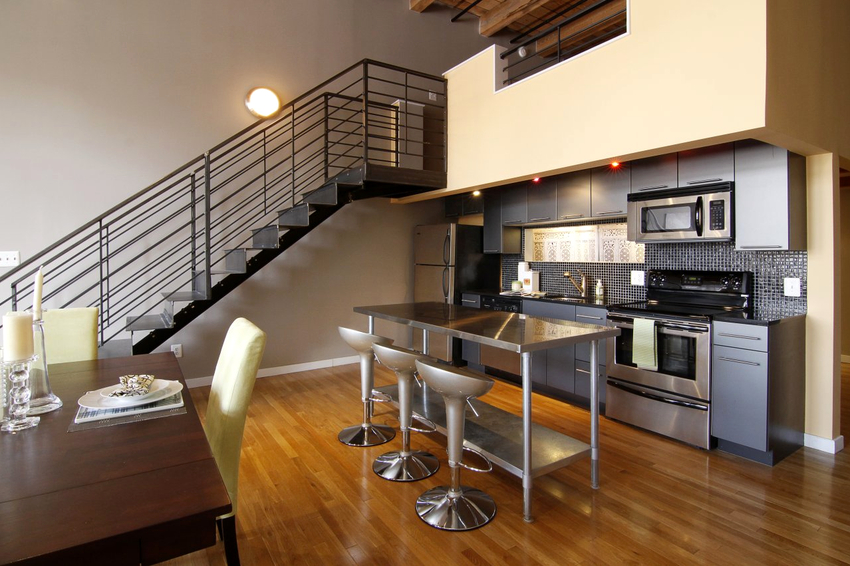
When installing metal railings with your own hands, you need to remember that their main task is safety
DIY step-by-step instructions for installing handrails
Before starting the installation, first of all, you need to perform a preliminary layout of the structure for the racks. To do this, step back from the edge of the step by 5-10 cm, 30-60 cm should remain between the holes.As already noted, the first and last racks are initially installed, and then the procedure will depend on the chosen installation method:
- For a single fastening, holes with a diameter of 1.6 cm are drilled, while they need to be deepened by at least 1.2-1.5 cm. Dowels for balusters are inserted into the finished cavities.
- If flange mounting is expected, 3 holes are made for installing dowels 8 cm long and 1.2 cm in diameter.
Before proceeding with the installation of the balusters, a cord is pulled between the pre-installed posts. It is important to ensure that the elements are not fastened at the points of broken railings or elevation differences. If the installation of stainless steel handrails is performed, they are first cut to length, while marking the places for the balusters. After that, it is attached to the hinges and securely fixed. It is permissible to fasten stainless handrails to balusters using self-tapping screws or from the front side to flanges.
When the crossbars are the main filling elements, they are cut and the marking of the attachment points on the racks is applied. If you plan to install glass panels, you must first fix the holder to the rack.
The installation of the racks from the side of the step is optimal when the minimum distance between the flights does not exceed 70 cm. In this case, the fixation takes place with expansion anchors, which are attached using an intermediate sleeve. For this, 2 holes are made at the end of the railing, where the anchor is inserted through the intermediate elements. The projecting end is closed by means of a cap nut. Sometimes it is permissible to use anchors without sleeves. If the railings are installed on a concrete staircase, it is possible to use liquid nails.
Helpful advice! Before installing the railing on the street, you need to make sure that the material will tolerate environmental influences without losing its appearance. Even some stainless steel products are recommended to be used only indoors or under a canopy.
Some ideas for creating beautiful metal railings
When choosing a railings, you need to take into account not only individual wishes, but also a harmonious combination of products with the interior. Some stairs look original even without railings, but the question of safe use remains open. Therefore, it is better to complement any design with handrails. Attractive design options:
- cast iron stairs look bulky and massive, but not suitable for every interior;
- forged and cast railings will actually fit into the classic interior with elements of aristocracy;
- various patterns will fill the room with a palace motif;
- the openwork version of the metal railings will add lightness to the staircase and transform any structure
- a wooden staircase with metal railings will emphasize the rustic style, chalet interior or classics;
- using a variety of weaves, shapes and geometric shapes will help create a real work of art in the home.
A staircase is an integral part of a house or apartment of several floors. The whole structure is a continuation of the interior. Railings that continue the pattern of the walls will look very nice and harmonious. When choosing a railing design, one should not forget about safety rules. Metal is a durable material, but even despite this, you should correctly install the railings and take care of them, only in this case it will be possible to create not only a beautiful, but also a safe interior.












